At finde de bedste objektiver til Sony og Canon spejlløse kameraer kan være overvældende i betragtning af de utallige muligheder på markedet. Som fotograf med mange års erfaring med at fotografere med begge systemer forstår jeg, hvor vigtigt det er at vælge det rigtige objektiv til at løfte dit arbejde, uanset om du er en erfaren professionel eller en entusiastisk begynder.
I denne guide vil jeg lede dig gennem de bedste muligheder, der leverer enestående ydeevne til forskellige behov – fra portrætter og landskaber til makro og video.
Sony og Canon er førende inden for spejlløse kameraer , kendt for deres avancerede teknologi og fremragende billedkvalitet. Deres økosystemer kan prale af en bred vifte af objektiver, inklusive førsteklasses linser til knivskarpe billeder, alsidige zoomobjektiver og specialiseret optik som makroobjektiver . Jeg vil også tage fat på nøglefaktorer, der skal overvejes, såsom blænde, brændvidde og kompatibilitet med full-frame- eller APS-C-sensorer.
Uanset om du optager med et Sony Alpha-seriekamera eller et Canon EOS R-system , kan investering i det rigtige objektiv frigøre dit kreative potentiale. Jeg vil også fremhæve nogle fremragende tredjepartsmuligheder, såsom Sigma Art-objektiver og Tamron-objektiver , som ofte leverer professionelle resultater til en brøkdel af prisen.
I slutningen af denne artikel har du alle de oplysninger, du behøver for at træffe en sikker, informeret beslutning.
6 bedste objektiver til Sony og Canon spejlløse kameraer
- Sony E PZ 10-20mm F4 G
- Sony FE 50 mm F2,5 G
- Sony E PZ objektiv 18-200mm F3.5-6.3 OSS
- Canon RF 85mm F2 Macro IS STM
- Canon RF 16mm F2.8 STM objektiv
- Canon EF 16–35 mm F2.8 L III USM-objektiv
Hvad gør spejlløse kameralinser anderledes?
Når det kommer til fotografering, er objektiver lige så vigtige som selve kameraet. De er ansvarlige for at forme lyset, der kommer ind for at tage billeder. Der findes objektiver til alle typer kameraer, hver med unikke egenskaber, der adskiller dem fra de andre.
I dette tilfælde vil vi fokusere på objektiver til spejlløse kameraer fra Sony og Canons mærker , fremtiden for digital fotografering. Hvis du stadig ikke ved, hvad spejlløse kameraer er, forklarer vi her i detaljer alt, hvad du behøver at vide om dem. Og hvis du allerede er en ekspert på området, så tjek, hvad der ifølge vores eksperter er den bedste kvalitetspris for EVIL eller spejlløse kameraer i øjeblikket.
Og med revolutionen af spejlløse kameraer er en ny æra af objektiver blevet indviet, designet til at drage fuld fordel af disse meget avancerede kameraer. I denne artikel hjælper vi dig med at lære de bedste spejlløse linser lidt bedre at kende, så du ved, hvordan du forstår dem, og hvilken du skal vælge, gennem branchens to titaner, Sony og Canon .
Før vi begynder at analysere funktionerne i de bedste spejlløse objektiver, er det vigtigt at forstå, hvad de bruges til, og hvorfor vi ikke kan bruge de samme objektiver til ethvert kamera.
Spejlløse linser er specielt designet til spejlløse kameraer, som adskiller sig fra dem, der findes i mangel på spejl og optisk søger, der er karakteristisk for spejlreflekskameraer. Disse kameraer bruger digital teknologi til at vise billedet på en LCD-skærm eller elektronisk søger, hvilket kræver objektiver tilpasset denne nye konfiguration.
Inden for dem kan vi klassificere objektiverne til APS-C eller Full Frame spejlløse kameraer i henhold til størrelsen på deres sensor. Vi ved, at dette kan være en smule kompliceret, men i den linkede artikel forklarer vi sammenligningen mellem Full Frame vs APS-C sensorer, så du bedre forstår forskellen mellem de to.
Sådan skelnes Sony eller Canon spejlløse objektiver

Før du viser dig de bedste objektiver til Sony eller Canon spejlløse kameraer, bør du kende betydningen bag deres akronymer.
Canon nomenklatur
Hvis du har glemt nogle Canon-nomenklaturer, giver vi dig her betydningen af nogle flere:
- Generation : Disse er romertal, der angiver udviklingsfasen af målet. Når designet er forbedret, ændres tallet (III er nyere end II).
- L : L står for luksus, vi kan finde det i professionelle linser med storslået optisk kvalitet. De har en rød ring omkring enden.
- DO: Står for "Diffractive Optics". Disse linser bruger specielle elementer for at gøre dem mere kompakte uden at miste kvaliteten. De har en grøn ring omkring enden.
- DS : De har en slør-reducerende belægning.
- IS : Den har billedstabilisering, der reducerer kamerarystelser og giver skarpere billeder.
- USM : Ultralyds autofokusmotor. De er meget hurtigere og har manuel fokuskontrol.
- STM : Steppermotorteknologi. Den har en roligere og mere jævn fokusering, ideel til at lave videoer og fotos.
- Nano USM : Det har fordelene ved STM- og USM-motorer i én.
- Makro : Dette er objektiver designet til at tage nærbilleder og fange detaljer meget tæt på motivet.
Sony nomenklatur
Føler du dig overvældet, når du ser en række tal og bogstaver i navnet på en linse, fordi du ikke ved, hvad de betyder? Dette spørgsmål er meget almindeligt blandt begyndere fotografer, og det er meget vigtigt at kende disse oplysninger for at vælge de bedste Sony og Canon spejlløse objektiver. Nedenfor forklarer vi alt i detaljer.
Denne sum af bogstaver og tal i målnavnet angiver:
- Brændvidde i millimeter : hvis der kun er ét tal, er det et fast objektiv, mens hvis det er et interval, er det et zoomobjektiv. Eksempel: 50 mm eller 18–55 mm.
- Lukkerblænde (F) : Dette tal svarer til lukkeråbningsværdien, når objektivet har den bredeste blænde (når tallet er lavest). Jo lavere værdi, jo hurtigere objektiv.
Disse to klassifikationer er grundlæggende og fælles for alle linsemærker. I dette tilfælde adskiller Sony sig ved at bruge sin egen nomenklatur :
- SEL : er navnet på objektiver med E-mount type (E-Mount) .
Bedste objektiver til Sony og Canon spejlløse kameraer
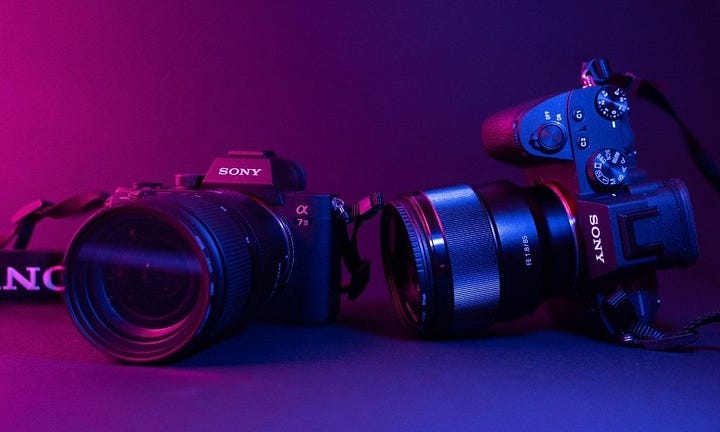
Her går vi med den samling, du var ivrig efter at se: de bedste objektiver til spejlløse modeller fra Sony og Canon.
3 bedste objektiver til Sony spejlløse kameraer
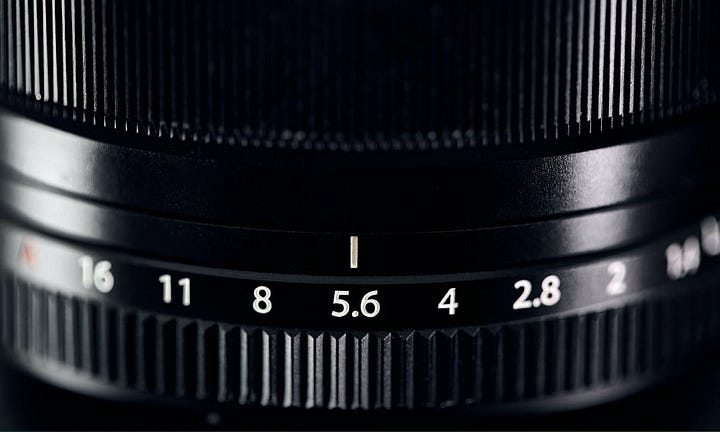
Nomenklaturerne forklaret, lad os se på de tilsvarende koder :
- E : Denne kode angiver, at det er et objektiv til et kamera med en APS-C sensor. Det kan være forvirrende, da det er det samme bogstav som monteringstypen, så vær meget forsigtig, hvis du har et spejlløst kamera i fuld ramme, for det vil beskære billedet.
- PZ : angiver motoriseret zoom. Disse linser er normalt avancerede, da de har mere avanceret teknologi end de grundlæggende.
1. Sony E PZ 10-20 mm F4 G
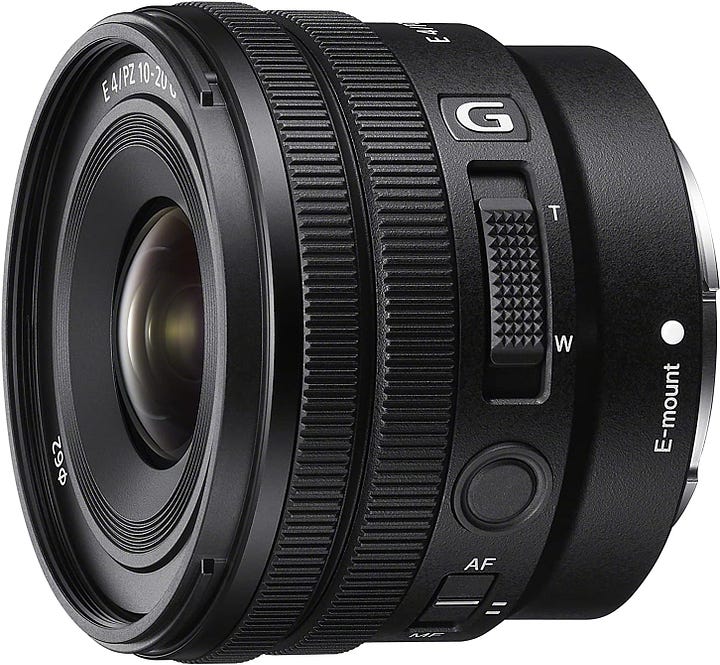
Denne zoom er det bedste valg til et APS-C vidvinkelobjektiv med dets 10–20 mm rækkevidde, super alsidigt til landskaber og arkitektur. Dens kompakte design, præcise fokusering og billedstabilisering gør den ideel til rejser og video. Den tilbyder optisk G-kvalitet og kontrolring .
FE : i dette tilfælde henviser det til, at det er et objektiv, der er kompatibelt med et kamera med en Full Frame billedsensor.
2. Sony FE 50 mm F2,5 G
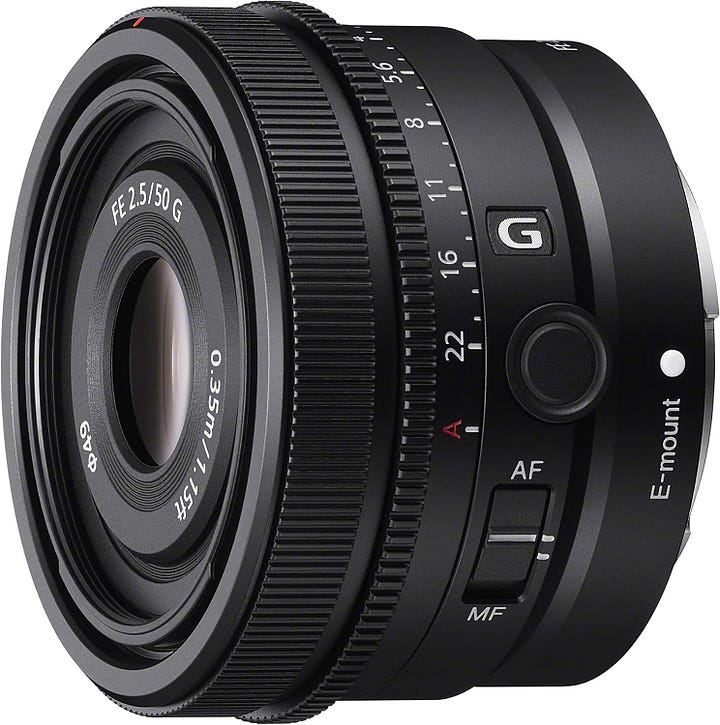
Uden tvivl et must-have for enhver fotograf. Der er intet bedre eksempel på et Sony Full Frame-objektiv end 50 mm G-serien , en kompakt perle designet til Sony Full Frame spejlløse kameraer. Den er den mest alsidige og perfekt til portrætter med sin G-kvalitet, hurtige og præcise fokusering, samt at den er let og bærbar.
Et objektiv beregnet til fuldformat kan være kompatibelt med ethvert kamera i denne holder.
Hvorimod et objektiv skabt til en APS-C-sensor kunne passe til et fuldformatkamera, men ville forårsage vignettering (mørkning omkring billedet). Selvom der findes adaptere til disse, kan der også forekomme tab af autofokus.
Derudover har Sony Full Frame-objektiver generelt en tendens til at være dyrere og tungere, fordi deres optik skal dække et større overfladeareal.
- Sonnar T (osv.): Vi vil kun se denne kode, hvis det er et Carl Zeiss-objektiv.
- G eller GM : Denne kode angiver, at den tilhører en af disse to serier (G eller G-Master Premium) af højkvalitets Sony-objektiver. Vi har allerede set, hvordan G-serien fungerer, men GM er endnu bedre og perfekt til professionelle.
Et fantastisk valg er dette G-Master -objektiv, et mesterværk til FE E-mount spejlløse kameraer og et af Sonys bedste objektiver. Dens faste brændvidde på 85 mm gør den til et førsteklasses valg til portrætter og tilbyder en storslået bokeh-effekt takket være dens brede blændeåbning. Dens optiske kvalitet og skarphed er enestående. Hurtig og præcis fokusering, sammen med dens robuste konstruktion, gør den ideel til at fange detaljer med høj kvalitet under en række forskellige forhold.
- ZA : til Carl Zeiss-objektiver.
- OSS — Angiver, at objektivet har en indbygget billedstabiliseringsfunktion. Denne funktion er især god til zoomobjektiver, da denne type fotografering ofte kræver at tage et billede, der kan tage timer og timer (i nogle tilfælde uden stativ), som det sker i naturen.
3. Sony E PZ Lens 18-200mm F3.5-6.3 OSS
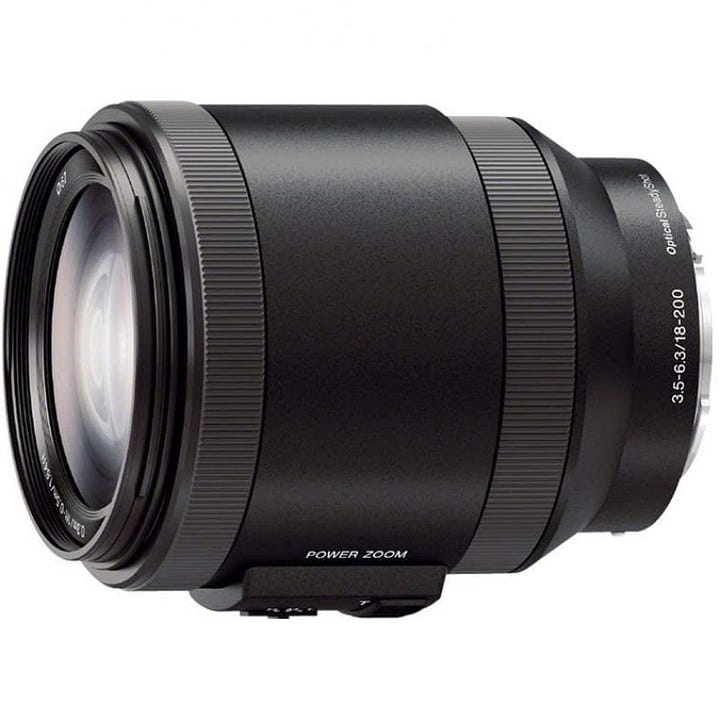
Dette Sony 18–200 mm APS-C zoomobjektiv er en meget alsidig zoom med et bredt brændvidde, velegnet til at optage en række forskellige scener fra landskaber til telefoto.
Dens optiske billedstabilisering (OSS) hjælper med at reducere uønskede rystelser. Selvom dens variable f/3.5–6.3 blænde kan begrænses i svagt lys, gør dens kompakte og lette design den praktisk til rejser og fotografering på farten.
- LE : Disse er Light Edition-objektiver, med mindre vægt og størrelse.
A-fatningen svarer til kameraer, der har et spejl, det vil sige spejlrefleks- eller DSLR- kameraer. Vi dækkede dem i vores indlæg om de bedste DSLR-kameraer for pengene.
Anmeldelser af foto- og videoudstyr
Bedste webcams til streaming og arbejde | Bedste Polaroid Instant Camera | Bedste babyalarm | Bedste undervandskamera | Bedste underlige gaveideer | Bedste luftpistol på Amazon | Bedste alt-i-én-computer
3 bedste objektiver til Canon spejlløse kameraer
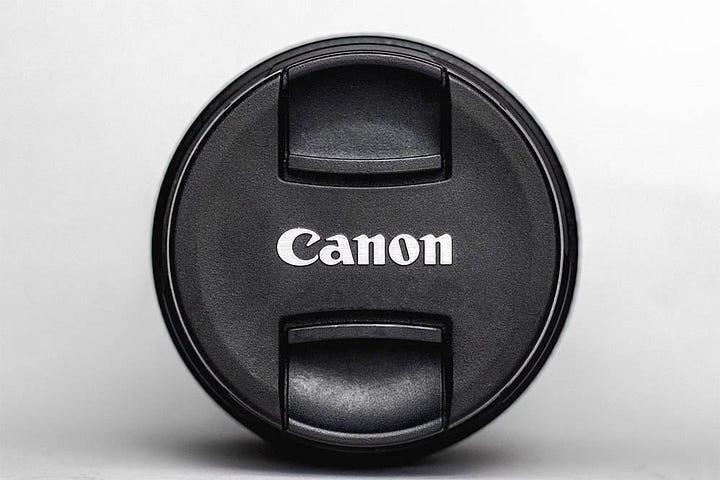
Hos Canon finder vi fem forskellige typer objektivfatning: RF, RF-S, EF, EF-S og EF-M.
RF og RF-S
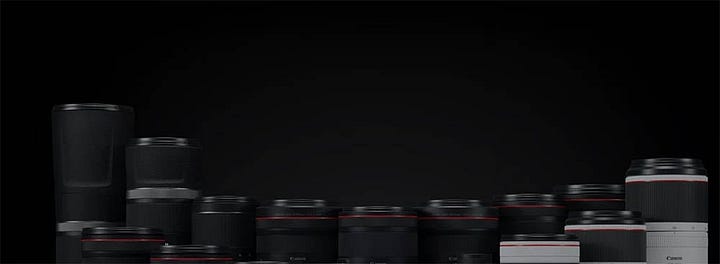
RF- og RF-S-objektiver er designet til Canons EOS R-system spejlløse kameraer. Inden for dette område deler både Full Frame og APS-C et avanceret RF-montering.
Ud over objektiver med enestående fokuseringsteknologier og optisk kvalitet, muliggør RF-fatningen hurtigere dataoverførsel mellem objektivet og kameraet. Dette udmønter sig i avanceret autofokussporing, forbedret billedstabilisering, realtidsoptimering og andre væsentlige fremskridt.
Men selvom du kan bruge RF-objektiver til APS-C-kameraer , vil der altid være en vis crop-faktor. Af denne grund var udseendet af EOS R7 og EOS R10 nøglen til fremkomsten af nye RF-S-objektiver, der er specielt designet til RF-monterede kameraer med APS-C-sensorer .
4. Canon RF 85mm F2 Macro IS STM — Kompakt medium telefoto sort linse
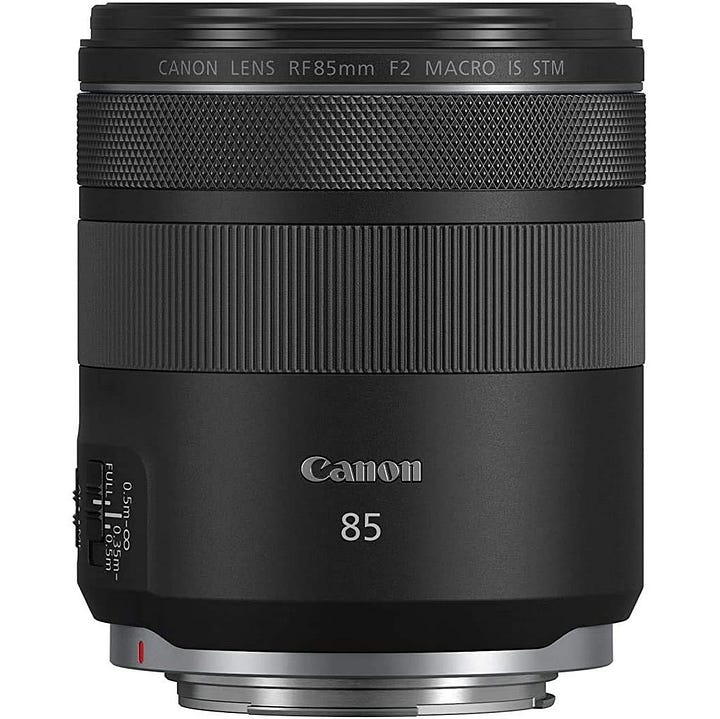
Hvis du overvejer at købe et portrætobjektiv, er en af de bedste, du kan finde på markedet, uden tvivl 85 mm Macro .
Et alsidigt objektiv, der er i stand til at fange essensen af dine motiver med en bred blændeåbning, hvilket skaber meget slående slørede baggrunde. Dens hybride optiske stabiliseringssystem (IS) giver større skarphed i svagt lys, og dens STM-motor til hurtig og lydløs fokusering er ideel til fotografering og video.
5. Canon RF 16mm F2.8 STM-objektiv
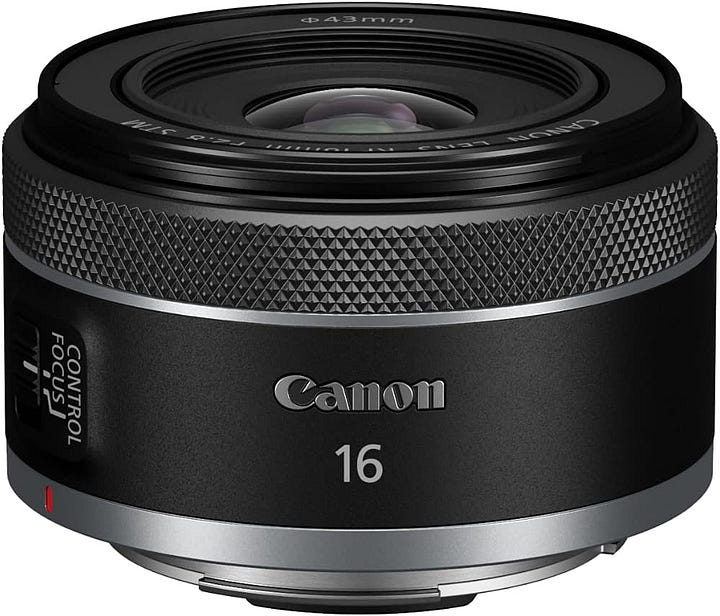
På den anden side, hvis du vil have en vidvinkel, bør du gå efter 16 mm- objektivet, et kreativt vidunder, der fanger unikke og brede perspektiver og giver alsidighed under forskellige lysforhold.
Den er også udstyret med en STM-motor, hurtig og lydløs fokusering til fotografering og video. Dens kompakte design gør den til den ideelle ledsager til rejser, vlogging eller astrofotografering.
Kameraerne i EOS R-serien kan bruges med de EF- og EF-S-objektiver, der er beskrevet nedenfor, ved hjælp af en adapter .
EF

EF står for "Electronic Focus" og er det ældste objektivfatning fra Canon ; det er dog også det mest kompatible med forskellige Canon-kameraer. Denne type objektivfatning svarer til mærkets spejlrefleks- eller DSLR-kameraer, både Full Frame og APS-C (med crop-faktor).
6. Canon EF 16–35 mm F2,8 L III USM-objektiv
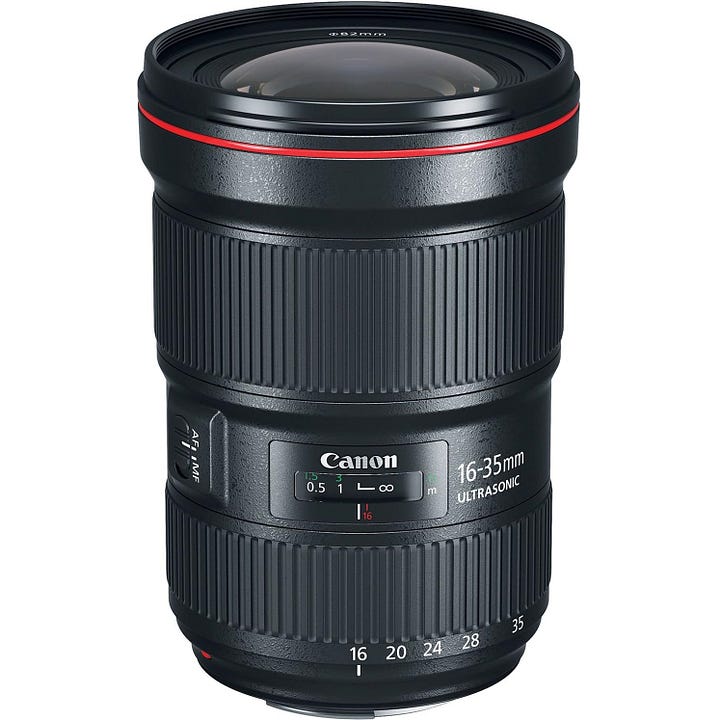
Hvis du er en meget krævende fotograferingsprofessionel og leder efter et af de bedste og mest alsidige Canon-objektiver til hverdagsbrug, er den bedste mulighed 16–35 mm .
Den fanger alt fra vid udsigt til detaljerede scener. Meget lysstærk og udstyret med ultrahurtig USM autofokus. Dens robuste konstruktion gør den velegnet til enhver udfordring.
Det er værd at nævne, at EF-objektiver også kan bruges med EOS M- og EOS R-kameraer ved hjælp af en adapter .
EF-S

EF-S eller korte bagfokusobjektiver er designet til Canon APS-C DSLR-kameraer og er ikke kompatible med Full Frame DSLR-kameraer. Disse linser er mindre i størrelse og vægt på grund af deres design til en mindre sensor.
På grund af teknologiske fremskridt inden for fotografering bliver disse typer objektiver og APS-C SLR-kameraer ikke længere fremstillet af Canon og Sony, så deres tilbud reduceres i stigende grad.
EF-M

Denne type objektivfatning er systemet designet specielt til spejlløse kameraer i Canon EOS M-serien.
11–22 mm vidvinkelobjektivet er et lovende valg for fotografer, der ønsker at fange fantastiske landskaber eller unikke perspektiver, fra ultravide visninger til detaljerede billeder. Dens kompakte og lette design gør den ideel til at bære rundt på. Den har en STM-motor med jævn og lydløs fokusering og optisk stabilisering (IS) for at modvirke uønsket bevægelse.
Ligesom i omvendt rækkefølge kan EOS M-kameraer også bruges med EF- og EF-S-objektiver ved hjælp af en adapter .
Dette er alt hvad du behøver at vide for at vælge de bedste Canon og Sony spejlløse objektiver, der passer til dine fotograferingsbehov. Hvis du leder efter de bedste kameraer til dit indhold, er her de bedste DSLR-kameraer for pengene.
Partnerindlæg af Glenn ABC: Bedste objektiver til Sony og Canon Mirrorless Cameras: Komplet vejledning.











